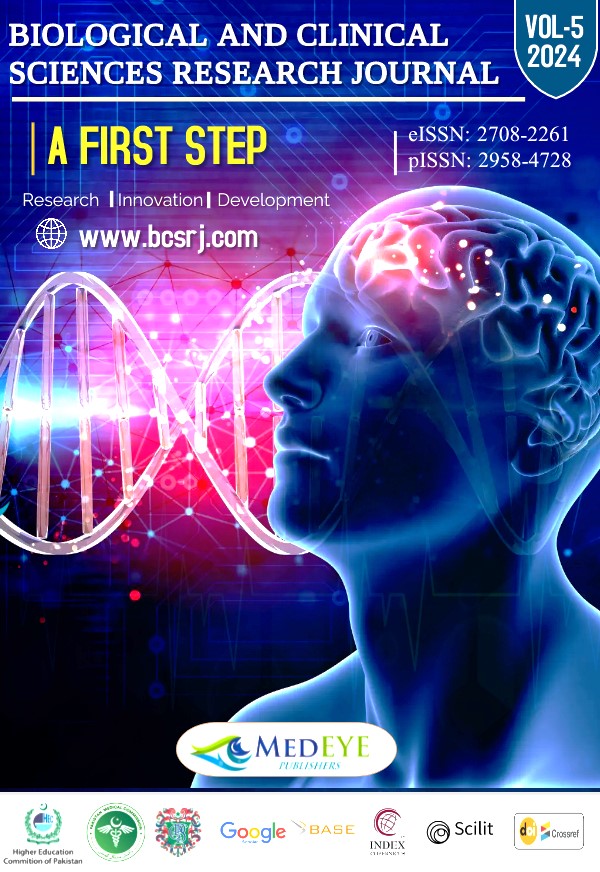OUTCOME OF ANTEPARTUM INTRAVENOUS FERRIC CARBOXYMALTOSE IN ANEMIC PATIENTS
DOI:
https://doi.org/10.54112/bcsrj.v2024i1.1490Keywords:
Efficacy, Ferric Carboxymaltose, Hemoglobin, Nervous SystemAbstract
Iron deficiency anaemia (IDA) is a prevalent condition among pregnant women, leading to increased maternal and fetal complications. Intravenous (IV) iron therapy, particularly ferric carboxymaltose (FCM), has been proposed as an effective treatment for rapid haemoglobin (Hb) improvement. Evaluating the effectiveness of FCM in achieving target Hb levels in a short duration is essential for optimising maternal health outcomes. Objective: To determine the efficacy of ferric carboxymaltose (FCM) in increasing haemoglobin levels for the treatment of iron deficiency anaemia (IDA) in pregnant women at a tertiary care hospital in Islamabad. Methods: A descriptive case series was conducted at a tertiary care hospital in Islamabad. The study included 110 pregnant women diagnosed with IDA. All participants received 5 mg of folic acid daily and were administered IV-FCM. Patients were monitored for three hours post-infusion for any adverse reactions and attended weekly follow-ups. Hemoglobin levels and iron profile were reassessed after three weeks to evaluate treatment efficacy. Data analysis was performed using SPSS version 20, with results presented as mean ± standard deviation (SD) and frequencies. Results: The mean age of participants was 25.67 ± 5.47 years (range 18–40 years). The effectiveness of IV-FCM in increasing haemoglobin levels within three weeks was observed in 80 (72.73%) of patients, indicating a high success rate. Conclusion: Ferric carboxymaltose (FCM) is effective in achieving target haemoglobin levels (≥11 g/dL) within three weeks in pregnant women with IDA, with minimal side effects. These findings support using IV-FCM as a safe and efficient treatment for iron deficiency anaemia during pregnancy.
Downloads
References
Cappellini MD, Santini V, Braxs C, Shander A. Iron metabolism and iron deficiency nemia in women. Fertil Steril. 2022;118(4):607-14.
Davidson EM, Scoullar MJL, Peach E, Morgan CJ, Melepia P, Opi DH et al. Quantifying differences in iron deficiency-attributable anemia during pregnancy and postpartum. Cell Rep Med. 2023;4(7):101097.
Ali SA, Abbasi Z, Shahid B, Moin G, Hambidge KM, Krebs NF, et al. Prevalence and determinants of anemia among women of reproductive age in Thatta Pakistan: Findings from a cross-sectional study. PLoS One. 2020;15(9):e0239320.
Najam A, Akhtar S, Khan A, Fatima U, Fakeer Muhammad S. Prevalence of Severe Anemia among Pregnant Females and Factors Associated With Anemia in Pregnancy. Pak J Med & Health Sci. 2022;16(6).
Shi H, Chen L, Wang Y. Severity of Anemia During Pregnancy and Adverse Maternal and Fetal Outcomes. JAMA Netw Open. 2022;5(2):e2147046.
Edelson PK, Cao D, James KE, Ngonzi J, Roberts DJ, Bebell LM,et al. Maternal anemia is associated with adverse maternal and neonatal outcomes in Mbarara, Uganda. J Matern Fetal Neonat Med. 2023;36(1):2190834.
Benson AE, Shatzel JJ, Ryan KS, Hedges MA, Martens K, Aslan JE et al. The incidence, complications, and treatment of iron deficiency in pregnancy. Eur J Haematol. 2022;109(6):633-642
Vanobberghen F, Lweno O, Kuemmerle A, Mwebi KD, Asilia P, Issa A, et al. Efficacy and safety of intravenous ferric carboxymaltose compared with oral iron for the treatment of iron deficiency anaemia in women after childbirth in Tanzania: a parallel-group, open-label, randomised controlled phase 3 trial. Lancet Glob Health. 2021;9(2):e189-e198
Mishra V, Gandhi K, Roy P, Hokabaj S, Shah KN. Role of Intravenous Ferric Carboxy-maltose in Pregnant Women with Iron Deficiency Anaemia. J Nepal Health Res Counc. 2017;15(36):96-9.
Breymann C, Milman N, Mezzacasa A, Bernard R, Dudenhausen J. Ferric carboxymaltose vs. oral iron in the treatment of pregnant women with iron deficiency anemia: an international, open-label, randomized controlled trial (FER-ASAP). J Perinat Med. 2017;45(4):443–53
Friedrisch JR, Canc¸ado RD. Intravenous ferric carboxymaltose for the treatment of iron deficiency anemia. Rev Bras Hematol Hemoter. 2015;37(6):400–405
Ghosh SK, Mondal R, Mandal S, Arindam De. A comparative study of ferric carboxymaltose and iron sucrose as a parenteral iron treatment in iron deficiency anemia during pregnancy in a tertiary care hospital. Asian J Med Sci. 2024 Apr;15(4):91-8
Koduru P, Abraham BP. The role of ferric carboxymaltose in the treatment of iron deficiency anemia in patients with gastrointestinal disease. Ther Adv Gastroenterol 2016;9(1):76–85
Pels A, Ganzevoort W. Safety and e9cacy of ferric carboxymaltose in anemic pregnant women: a retrospective case control study. Obstet Gynecol Int.2015;7.
Van Wyck DB, Martens MG, Seid MH, Baker JB, Mangione A. Intravenous ferric carboxymaltose compared with oral iron in the treatment of postpartum anemia. Obstet Gynecol. 2007;110(2)Part1:267–78.
Evstatiev R, Alexeeva O, Bokemeyer B, Chopey I, Felder M, Gudehus M. et al. Ferriccarboxymaltose prevents recurrence of anemia in patients with inflammatory bowel disease. Clin Gastroenterol Hepatol. 2013;11:269–77.
Kaur R, Kant S, Haldar P, Ahamed F, Singh A, Dwarakanathan V, et al. Single Dose of Intravenous Ferric Carboxymaltose Prevents Anemia for 6 Months among Moderately or Severely Anemic Postpartum Women:A Case Study from India. Current Devel Nutrit. 2021;1-4
Jose A, Mahey R, Sharma JB, Bhatla N, Saxena R, Kalaivani M, et al. Comparison of ferric Carboxymaltose and iron sucrose complex for treatment of iron deficiency anemia in pregnancyrandomised controlled trial. BMC Pregnancy Childbirth. 2019;19:54
Breymann C, Milman N, Mezzacasa A, Bernard R, Dudenhausen J. Ferric carboxymaltose vs. oral iron in the treatment of pregnant women with iron deficiency anemia: an international, open-label, randomized controlled trial (FER-ASAP). J Perinat Med. 2017;45(4):443–53
Christoph P, Schuller C, Studer H, Irion O, De Tejada BM, Surbek D. Intravenous iron treatment in pregnancy: comparison of high-dose ferric carboxymaltose vs. iron sucrose. J Perinat Med. 2012;40:469–74.
Joshi SD, Chikkagowdra S, Kumar V. Comparative study of efficacy and safety of intravenous ferric carboxymaltose versus iron sucrose complex in treatment of postpartum iron deficiency anemia. Int J Reprod Contracept Obstet Gynecol 2017;5(8):2566-70
Singh A, Yerragudi R. Comparative study of safety and efficacy of intravenous Iron sucrose Complex and ferric carboxymaltose in the treatment of postpartum iron deficiency anemia. Int J Reprod Contracept Obstet Gynecol 2016; 5(4):1130-3.
Lyseng-Williamson KA, Keating GM. Ferric carboxymaltose: a review of its use in iron-deficiency anaemia. Drugs. 2009;69(6):739–56.
Sharma N, Thiek JL, Natung T, Ahanthem SS. Comparative study of efficacy and safety of ferric carboxymaltose versus iron sucrose in post-partum anaemia. J Obstet Gynaecol India. 2017;67(4):253–7
Downloads
Published
How to Cite
Issue
Section
License
Copyright (c) 2024 A FAIZ , F ASHIQ , Z KAUSAR , L SALEEM , S BATOOL , N FAROOQ

This work is licensed under a Creative Commons Attribution-NonCommercial 4.0 International License.








